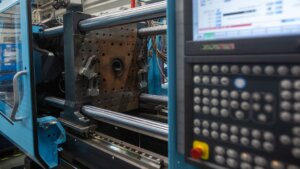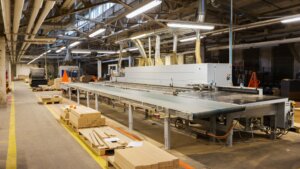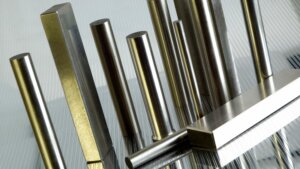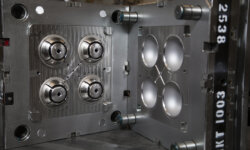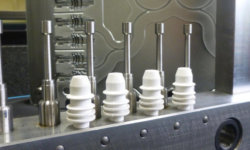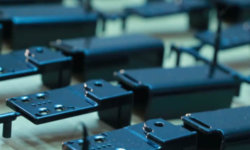Injection molding stands as a cornerstone in the manufacturing world, revolutionizing the production of parts across a myriad of industries. This method, known for its efficiency and versatility, shapes the way products are created, from everyday household items to intricate components in specialized fields. Injection molding, a manufacturing technique revered for its precision and scalability, has become indispensable in modern production processes.
What Is Injection Molding?
At its core, injection molding is a manufacturing process that involves the injection of molten material into a mould cavity. This process, primarily used with plastics, allows for high-volume production of parts with intricate shapes and detailed features.
The versatility of injection molding lies in its ability to handle various materials – from thermoplastics and thermosetting polymers to metals and glass. This adaptability, combined with design flexibility, makes it a preferred choice for manufacturers seeking efficiency and cost-effectiveness in their production volumes.
What are the Applications of Injection Molding in Various Industries?
The applications of injection molding are as diverse as the industries it serves. This manufacturing technique finds its place in creating components that range from tiny, precision parts in medical devices to large, robust components used in construction and automotive industries.
Injection molding’s influence extends to consumer products, where it plays a pivotal role in forming items that we use daily, showcasing its remarkable capacity to meet various consumer needs.
Each industry demands unique specifications and qualities in the components, which injection molding adeptly delivers through its versatile processes.
Construction Industry
In the construction industry, injection molding is vital in producing durable components such as connectors, brackets, and housing elements. These parts, often made from robust plastics or composites, must withstand environmental stresses and bear significant loads, making the strength and consistency offered by injection molding invaluable. The process lends itself to the production of a wide array of items, essential for both residential and commercial construction. Key applications include:
- Window and door frames that offer both durability and aesthetic appeal.
- Plumbing fixtures like joints and valves, which demand precision and resistance to wear.
- Electrical boxes and insulation components, ensuring safety and efficiency in electrical installations.
- Modular construction elements, which facilitate faster and more cost-effective building processes.
Food Industry
For the food and beverage sector, injection molding is employed to create packaging and food-safe products. Items like bottle caps, containers, and utensils are manufactured with food-grade materials, ensuring safety and compliance with health regulations. The versatility of injection molding in the food industry is demonstrated by its ability to produce a broad range of products, including:
- Custom-designed packaging for unique food products, enhancing both functionality and brand visibility.
- Disposable cutlery and dinnerware, providing convenience and hygiene for fast food and catering services.
- Airtight sealing solutions for food containers, crucial for maintaining freshness and preventing contamination.
- Beverage bottles and caps, including those for carbonated drinks, requiring specific designs to handle pressure.
Medical Injection Molding
In the medical sector, injection molding plays a crucial role in producing high-quality, durable, and sterile components. Products range from small items like test kits and x-ray components to larger parts such as MRI machine housings. The process’s precision and ability to use materials that meet stringent FDA regulations make it invaluable in maintaining patient safety and product efficacy. The vast array of medical products and components manufactured through injection molding encompasses:
- Surgical instruments and components, designed for precision and ease of sterilization.
- Implantable medical devices, such as knee and hip replacements, which require biocompatible materials.
- Laboratory equipment and housings for diagnostic machines, ensuring accuracy and reliability.
- Drug delivery systems, including inhalers and insulin pens, which demand high precision and patient safety.
Defense Industry
In the defense industry, injection molding is indispensable for producing parts that require high strength and impact resistance. This process is crucial for fabricating a variety of components, ranging from intricate internal mechanisms to rugged exterior parts. Its applications in defense are diverse, demonstrating its capacity to handle various materials and complex shapes. Key applications include:
- Airplane and vehicle components, including dashboard panels, seat frames, and exterior body parts, all requiring durability and precision.
- Protective gear such as helmets, body armor plates, and communication device casings, which need to be both lightweight and resilient.
- Components for firearms and weaponry, including grips, stocks, and magazine parts, benefiting from the high-precision molding capabilities.
- Surveillance and communication device housings, which must be robust yet lightweight, demonstrating the process’s ability to produce parts with specific requirements.
Agriculture Implements and Tools
Injection molding has revolutionized the agricultural industry by providing robust, weather-resistant parts essential for modern farming. The technique excels in producing large volumes of durable items efficiently, making it ideal for agricultural applications. The scope of products includes:
- Machine parts for tractors and harvesters, such as dashboard housings, knobs, and levers, which require durability and UV resistance.
- Components for irrigation systems, including sprinkler heads and connectors, designed for longevity and resistance to various weather conditions.
- Containers and storage bins, which benefit from the molding process’s ability to create large, sturdy objects.
- Tools and implements, such as shovels and rakes, where the handles and other parts are produced with ergonomic designs and enhanced strength.
Electronic Industry
In the electronic industry, the precision and versatility of injection molding are critical in producing components for a wide range of devices. The process enables the manufacture of parts with intricate details and advanced materials, catering to the industry’s evolving demands. Prominent applications include:
- Housing for cell phones and other portable devices, where aesthetics and durability are essential.
- Computer and laptop components, including keyboard keys, USB port housings, and trackpad frames, requiring precision and a smooth surface finish.
- Cable management systems and connectors, which must withstand plugging and unplugging cycles while maintaining conductivity.
- Components for audio and visual equipment, such as speaker housings and remote controls, where the quality of the material contributes to the overall user experience.
Furniture Industry
Furniture manufacturing has wholeheartedly embraced injection molding for its unparalleled ability to produce durable, aesthetically pleasing, and innovative designs. This technique allows for a seamless blend of functionality and style, making it a staple in the furniture industry. The range of products that benefit from injection molding’s versatility in this sector includes:
- Chair bases and armrests, often created with complex designs and ergonomic shapes.
- Table components such as legs and supports, which require both strength and aesthetic appeal.
- Outdoor furniture pieces, like patio chairs and tables, which benefit from the durability and weather resistance of molded plastics.
- Modular shelving units and storage solutions, showcasing injection molding’s ability to create detailed and customizable designs.
- Office furniture components including desk organizers, drawer handles, and cable management systems, where precision and functionality are key.
Musical Industry
The music industry greatly benefits from the precision and consistency provided by injection molding. This method is instrumental in crafting components that require uniformity and high-quality materials, ensuring the optimal performance of musical instruments and accessories. Key applications include:
- Guitar picks and drumsticks, which demand precise dimensions and durability for consistent performance.
- Parts of wind instruments such as mouthpieces and valves, where accuracy in design directly impacts sound quality.
- Keyboard keys and piano components, requiring a smooth finish and precise measurements for proper functionality.
- String instrument accessories like tuning pegs and chin rests, which need to be both strong and comfortable for the user.
- Protective casings and covers for instruments, ensuring durability and protection while maintaining lightweight characteristics.
What Products Are Commonly Created Through Injection Molding?
Injection molding’s versatility is evident in the vast array of products it helps create. This process is pivotal in several industries, churning out items that are part of our daily lives.
Overview of product types:
- Consumer Electronics: Beyond casings for smartphones, remote controls, and battery compartments, injection molding plays a crucial role in manufacturing components like keyboard keys, mouse shells, and webcam frames. This manufacturing process ensures high-quality, durable, and aesthetically pleasing plastic parts that are integral to consumer electronics.
- Medical Devices and Components: The medical field benefits from injection molding in creating surgical instruments, diagnostic kits, prosthetic parts, and even intricate parts like x-ray components. The ability to use biocompatible materials makes injection molding a preferred method for medical devices, ensuring patient safety and product sterility.
- Automotive Parts: Injection molding is extensively used in the automotive industry to create dashboard components, cup holders, and bumpers. It also extends to producing intricate parts like light housings, air vents, and even interior trim pieces, showcasing the process’s ability to handle complex shapes and durable materials.
- Everyday Household Items: The versatility of injection molding is showcased in household items including kitchen appliances, containers, and bottle caps. Other common products include laundry baskets, toothbrushes, and plastic cutlery, emphasizing the process’s role in our daily lives.
- Packaging and Food-Safe Products: In the realm of food and beverage, injection molding is used to manufacture beverage containers, food storage solutions, and utensils. It also includes products like yogurt cups, coffee lids, and condiment bottles, highlighting the industry’s need for food-safe, durable, and functional packaging solutions.
- Agricultural Products: The agricultural sector relies on injection molding for tool handles, machinery components, and irrigation fittings. Additional items include seed trays, animal tags, and feeding troughs, underscoring the importance of durable and weather-resistant products in this sector.
- Defense Industry Parts: In the defense industry, injection molding is utilized for helmet components and communication device casings. The technique is also employed in manufacturing parts for protective gear, ammunition boxes, and equipment casings, requiring materials with high impact resistance and strength.
- Musical Instruments: Injection molding contributes to the music industry by producing keys for wind instruments, drum parts, and string instrument accessories. The process is also used in making durable music stands, instrument cases, and knobs and sliders for audio equipment, showcasing its role in both the manufacturing and functionality of musical products.
- Furniture: The furniture industry employs injection molding for chair bases, decorative elements, and functional hardware. It also extends to producing durable parts for outdoor furniture, ergonomic components for office chairs, and sleek, modern elements for contemporary furniture designs.
What Are Some Innovative Products Made with Injection Molding?
Injection molding has paved the way for innovation, creating products that are not only functional but also push the boundaries of design and application. Some of these include advanced prosthetics that mimic human limb movement, lightweight components for aerospace applications, and sustainable materials used in eco-friendly products.
What Materials Are Used in Injection Molding?
A wide range of materials can be used in injection molding, each selected based on the specific requirements of the product being manufactured.
Thermoplastics
Thermoplastics are the most commonly used materials in injection molding, known for their versatility and recyclability. They are favored for their ability to be reheated and reshaped, allowing for corrections and recycling. Key types of thermoplastics and their applications include:
- ABS (Acrylonitrile Butadiene Styrene): Used for consumer products like toys, automotive components, and electronic housings due to its toughness and impact resistance.
- Polyethylene: Utilized in products requiring high ductility and low friction, such as containers, bottles, and plastic bags.
- Polycarbonate: Known for its transparency and heat resistance, it’s used in applications like eyewear lenses, bulletproof glass, and electronic displays.
Thermosetting Polymers
Once set, these materials cannot be melted again, making them ideal for products requiring high heat resistance. Applications of thermosetting polymers include:
- Epoxy Resins: Employed in electronic components and insulators due to their excellent electrical properties and chemical resistance.
- Phenolic Resins: Used in automotive and aerospace industries for parts that require high thermal stability and mechanical strength.
- Silicone: Ideal for cookware, medical devices, and seals, given its heat resistance and rubber-like flexibility.
Elastomers
Used for products that need flexibility, elastomers find applications in:
- Seals and Gaskets: Providing tight seals in machinery and plumbing systems due to their elastic properties.
- Automotive Parts: Such as tires, hoses, and belts, requiring durability and flexibility.
Metals
Metal injection molding is used for producing complex metal parts with high precision, including:
- Medical Tools: Like surgical instruments, which require precision and sterilizability.
- Firearms: For detailed components requiring strength and precision.
Glass
Used in specific applications requiring transparency and hardness, glass finds applications in:
- Optical Components: Like lenses and prisms that require clarity and precision.
- Home Decor: Such as decorative glassware and fixtures.
Confections
Injection molding in the food industry is creatively used for:
- Candy and Chocolate Molds: Creating intricate shapes and designs for confectionery products.
- Novelty Food Items: Like themed or custom-shaped candies and chocolates.
Conclusion
Understanding the applications of injection molding in various industries is crucial, not just for manufacturers but also for consumers and innovators. This technology’s ability to adapt to different materials and requirements has made it a cornerstone in modern manufacturing.
As we look to the future, the continuous evolution of injection molding promises even more innovative applications and advancements in manufacturing efficiency and product design.


